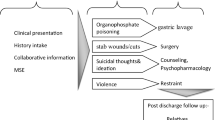Summary
The risk factors and precautions of inpatient suicide were explored. Thirty suicide victims were drawn from the adverse event reports of suicidal act during hospitalization in a general hospital from 2008 to 2014. Data were gathered from the focus group interviews of twelve nurses who had experienced inpatient suicide. The data were analyzed by using analytical technique based on grounded theory, and software QSR NVIVO8 was used to aid the collation of data. Three main themes of risk factors about inpatient suicide emerged from the analysis: individual value, social factors and environmental factors. The individual value was categorized into different groups such as sense of guilt, hopelessness and low self-esteem. Social factors included two aspects of negative life events and social support. Three themes of precautions about inpatient suicide appeared in this study: evaluation, nursing and information exchange. Evaluation was elaborated from both physical and psychological assessments. This finding extends existing work of risk factors and precautions about inpatient suicide and brings new knowledge about the reasons why inpatients commit suicide.
Similar content being viewed by others
References
Maris RW. Suicide. Lancet, 2002,360(9329):319–326
Neuner T, Schmid R, Wolfersdorf M, et al. Predicting inpatient suicides and suicide attempts by using clinical routine data. Gen Hosp Psychiatry, 2008,30(4):324–330
Høyer EH, Licht RW, Mortensen PB. Risk factors of suicide in inpatients and recently discharged patients with affective disorders: A case-control study. Eur Psychiatry, 2009,24(5):317–321
King EA, Baldwin DS, Sinclair JM, et al. The Wessex Recent In-Patient Suicide Study, 1. Case-control study of 234 recently discharged psychiatric patient suicides. Br J Psychiatry, 2001,178:531–536
King EA, Baldwin DS, Sinclair JM, et al. The Wessex Recent In-Patient Suicide Study, 2. Case-control study of 59 inpatient suicides. Br J Psychiatry, 2001,178:537–542
Cheng IC, Hu FC, Tseng MC. Inpatient suicide in a general hospital. Gen Hosp Psychiatry, 2009,31(2):110–115
Sun FK, Long A, Boore J, et al. Nursing people who are suicidal on psychiatric wards in Taiwan: action/interaction strategies. J Psychiatr Ment Health Nurs, 2005,12(3):275–282
Doody O, Slevin E, Taggart L. Preparing for and conducting focus groups in nursing research: part 2. Br J Nurs, 2013,22(3):170–173
Doody O, Slevin E, Taggart L. Focus group interviews in nursing research: part 1. Br J Nurs, 2013,22(1):16–19
Strauss AL, Corbin JM. Basic of Qualitative Research: Grounded Theory Procedures and Techniques. London: Sage, 1990.
Strauss AL, Corbin JM. Basic of Qualitative Research: Grounded Theory Procedures and Techniques, 2nd eds. London: Sage, 1998.
Eaves YD. A synthesis technique for grounded theory data analysis. J Adv Nurs, 2001,35(5):654–663
Willig C. Introducing Qualitative Research in Psychology. 2nd eds. GK: Post & Telecom Press, 2013.
Carlén P, Bengtsson A. Suicidal patients as experienced by psychiatric nurses in inpatient care. Int J Ment Health Nurs, 2007,16(4):257–265
Li XY, Michael P, Zhang YP. The study on the validity of a suicide-specific life event scale and suicidal behavior. Chin J Nerv Ment Di (Chinese), 2008,34(3):156–160
Wu JL, Lin DX, Jiang QJ, et al. Medical psychology. Beijing: Higher Education Press, 2001,77–78
Hu DY, Liu YL, Deng XF, et al. The thought: inpatient suicide in general tertiary hospitals. J Nursing Sci (Chinese), 2014,29(7):61–63
Sharma V, Persad E, Kueneman K. A closer look at inpatient suicide. J Affect Disord, 1998,47(1–3):123–129
Muir-Cochrane E, Oster C, Grotto J, et al. The inpatient psychiatric unit as both a safe and unsafe place: Implications for absconding. Int J Ment Health Nurs, 2013,22(4):304–312
Bowers L, Banda T, Nijman H. Suicide inside: a systematic review of inpatient suicides. J Nerv Ment Dis, 2010,198(5):318–328
Sinclair JM, Harriss L, Baldwin DS, et al. Suicide in depressive disorders: a retrospective case-control study of 127 suicides. J Affect Disord, 2005,87(1):107–113
Tishler CL, Reiss NS. Inpatient suicide: preventing a common sentinel event. Gen Hosp Psychiatry, 2009,31(2):103–109
Liu Y, Zhao G, Li F, et al. Nursing-related patient safety events in hospitals. J Huazhong Univ Sci Technolog Med Sci, 2009,29(2):265–268
Wiklander M, Samuelsson M, Jokinen J, et al. Shame-proneness in attempted suicide patients. BMC Psychiatry, 2012,12:50
Davidsen AS. ’And then one day he’d shot himself. Then I was really shocked’: general practitioners’ reaction to patient suicide. Patient Educ Couns, 2011,85(1):113–118
Kim B, Gillham DM. The experience of young adult cancer patients described through online narratives. Cancer Nurs, 2013,36(5):377–384
Pompili M, Innamorati M, Gonda X, et al. Affective temperaments and hopelessness as predictors of health and social functioning in mood disorder patients: A prospective follow-up study. J Affect Disord, 2013,150(2):216–222
Díaz-Martín A, González-Carpio Paredes Ó. Follow-up of primary care patients with a NANDA I nursing diagnosis of low self-esteem. Enferm Clin, 2013,23(5):196–202
Sakinofsky I. Preventing suicide among inpatients. Can J Psychiatry, 2014,59(3):131–140
Fairman N, Thomas LP, Whitmore S, et al. What did I miss? A qualitative assessment of the impact of patient suicide on hospice clinical staff. J Palliat Med, 2014,17(7):832–836
Author information
Authors and Affiliations
Corresponding author
Additional information
The authors contributed equally to this work.
This project was supported by Huazhong University of Science and Technology independent innovation fund in 2013-clinical skills, China (No. 01-18-530069).
Rights and permissions
About this article
Cite this article
Hu, Dy., Huang, D., Xiong, Y. et al. Risk factors and precautions of inpatient suicide from the perspective of nurses: A qualitative study. J. Huazhong Univ. Sci. Technol. [Med. Sci.] 35, 295–301 (2015). https://doi.org/10.1007/s11596-015-1427-0
Received:
Revised:
Published:
Issue Date:
DOI: https://doi.org/10.1007/s11596-015-1427-0



